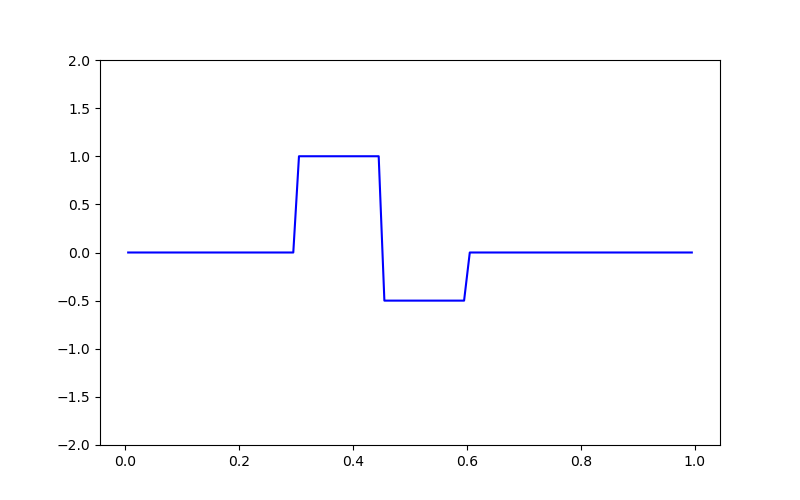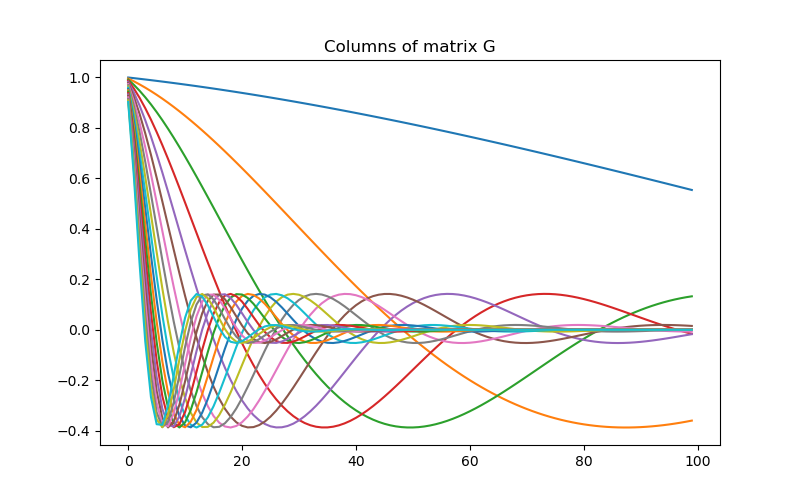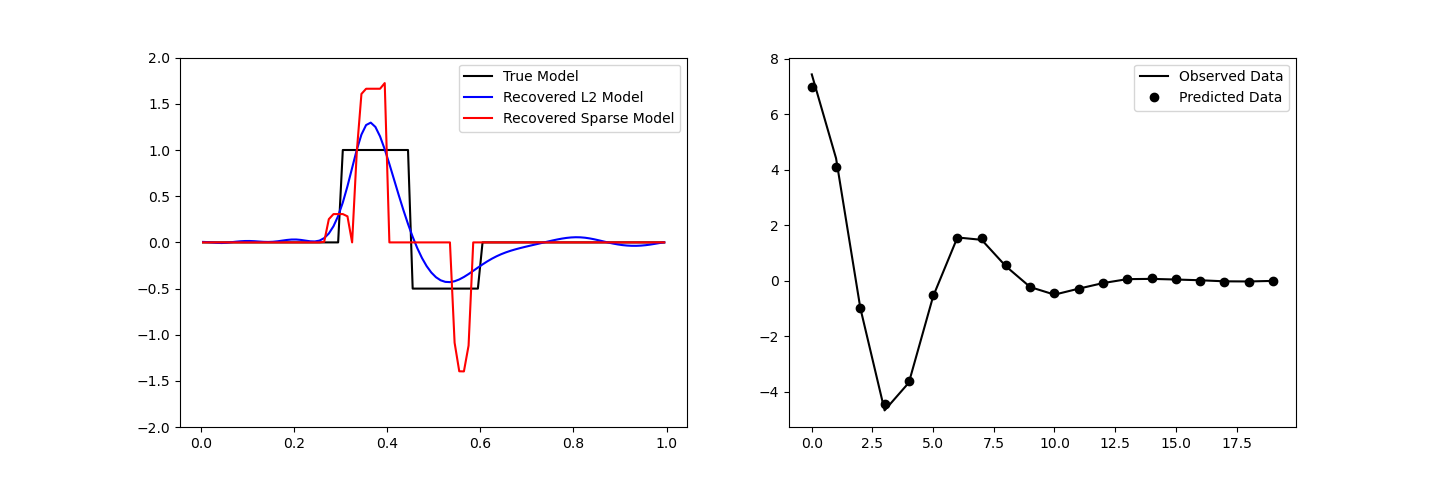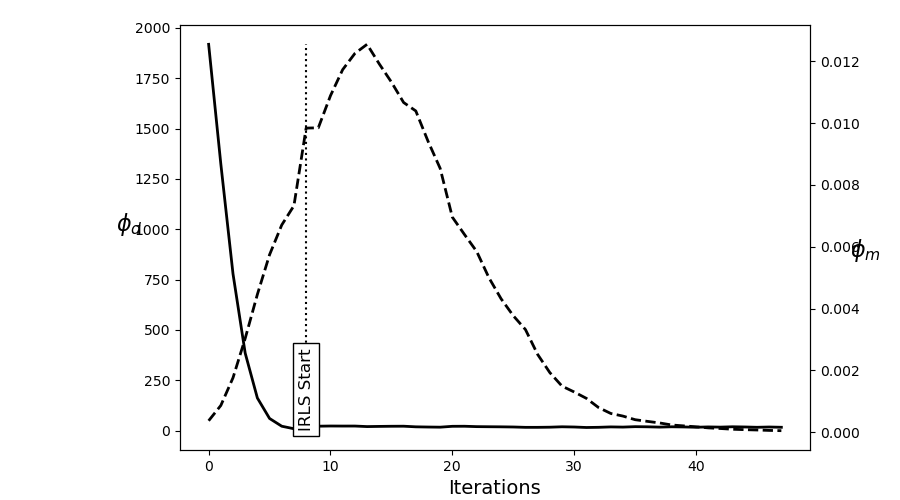Note
Go to the end to download the full example code.
Sparse Inversion with Iteratively Re-Weighted Least-Squares#
Least-squares inversion produces smooth models which may not be an accurate representation of the true model. Here we demonstrate the basics of inverting for sparse and/or blocky models. Here, we used the iteratively reweighted least-squares approach. For this tutorial, we focus on the following:
Defining the forward problem
Defining the inverse problem (data misfit, regularization, optimization)
Defining the paramters for the IRLS algorithm
Specifying directives for the inversion
Recovering a set of model parameters which explains the observations
import numpy as np
import matplotlib.pyplot as plt
from discretize import TensorMesh
from simpeg import (
simulation,
maps,
data_misfit,
directives,
optimization,
regularization,
inverse_problem,
inversion,
)
# sphinx_gallery_thumbnail_number = 3
Defining the Model and Mapping#
Here we generate a synthetic model and a mappig which goes from the model space to the row space of our linear operator.
nParam = 100 # Number of model paramters
# A 1D mesh is used to define the row-space of the linear operator.
mesh = TensorMesh([nParam])
# Creating the true model
true_model = np.zeros(mesh.nC)
true_model[mesh.cell_centers_x > 0.3] = 1.0
true_model[mesh.cell_centers_x > 0.45] = -0.5
true_model[mesh.cell_centers_x > 0.6] = 0
# Mapping from the model space to the row space of the linear operator
model_map = maps.IdentityMap(mesh)
# Plotting the true model
fig = plt.figure(figsize=(8, 5))
ax = fig.add_subplot(111)
ax.plot(mesh.cell_centers_x, true_model, "b-")
ax.set_ylim([-2, 2])

(-2.0, 2.0)
Defining the Linear Operator#
Here we define the linear operator with dimensions (nData, nParam). In practive, you may have a problem-specific linear operator which you would like to construct or load here.
# Number of data observations (rows)
nData = 20
# Create the linear operator for the tutorial. The columns of the linear operator
# represents a set of decaying and oscillating functions.
jk = np.linspace(1.0, 60.0, nData)
p = -0.25
q = 0.25
def g(k):
return np.exp(p * jk[k] * mesh.cell_centers_x) * np.cos(
np.pi * q * jk[k] * mesh.cell_centers_x
)
G = np.empty((nData, nParam))
for i in range(nData):
G[i, :] = g(i)
# Plot the columns of G
fig = plt.figure(figsize=(8, 5))
ax = fig.add_subplot(111)
for i in range(G.shape[0]):
ax.plot(G[i, :])
ax.set_title("Columns of matrix G")

Text(0.5, 1.0, 'Columns of matrix G')
Defining the Simulation#
The simulation defines the relationship between the model parameters and predicted data.
Predict Synthetic Data#
Here, we use the true model to create synthetic data which we will subsequently invert.
# Standard deviation of Gaussian noise being added
std = 0.02
np.random.seed(1)
# Create a SimPEG data object
data_obj = sim.make_synthetic_data(true_model, noise_floor=std, add_noise=True)
Define the Inverse Problem#
The inverse problem is defined by 3 things:
Data Misfit: a measure of how well our recovered model explains the field data
Regularization: constraints placed on the recovered model and a priori information
Optimization: the numerical approach used to solve the inverse problem
# Define the data misfit. Here the data misfit is the L2 norm of the weighted
# residual between the observed data and the data predicted for a given model.
# Within the data misfit, the residual between predicted and observed data are
# normalized by the data's standard deviation.
dmis = data_misfit.L2DataMisfit(simulation=sim, data=data_obj)
# Define the regularization (model objective function). Here, 'p' defines the
# the norm of the smallness term and 'q' defines the norm of the smoothness
# term.
reg = regularization.Sparse(mesh, mapping=model_map)
reg.reference_model = np.zeros(nParam)
p = 0.0
q = 0.0
reg.norms = [p, q]
# Define how the optimization problem is solved.
opt = optimization.ProjectedGNCG(
maxIter=100, lower=-2.0, upper=2.0, maxIterLS=20, maxIterCG=30, tolCG=1e-4
)
# Here we define the inverse problem that is to be solved
inv_prob = inverse_problem.BaseInvProblem(dmis, reg, opt)
Define Inversion Directives#
Here we define any directiveas that are carried out during the inversion. This includes the cooling schedule for the trade-off parameter (beta), stopping criteria for the inversion and saving inversion results at each iteration.
# Add sensitivity weights but don't update at each beta
sensitivity_weights = directives.UpdateSensitivityWeights(every_iteration=False)
# Reach target misfit for L2 solution, then use IRLS until model stops changing.
IRLS = directives.UpdateIRLS(max_irls_iterations=40, f_min_change=1e-4)
# Defining a starting value for the trade-off parameter (beta) between the data
# misfit and the regularization.
starting_beta = directives.BetaEstimate_ByEig(beta0_ratio=1e0)
# Update the preconditionner
update_Jacobi = directives.UpdatePreconditioner()
# Save output at each iteration
saveDict = directives.SaveOutputEveryIteration(save_txt=False)
# Define the directives as a list
directives_list = [
sensitivity_weights,
IRLS,
starting_beta,
update_Jacobi,
saveDict,
]
Setting a Starting Model and Running the Inversion#
To define the inversion object, we need to define the inversion problem and the set of directives. We can then run the inversion.
# Here we combine the inverse problem and the set of directives
inv = inversion.BaseInversion(inv_prob, directives_list)
# Starting model
starting_model = 1e-4 * np.ones(nParam)
# Run inversion
recovered_model = inv.run(starting_model)
Running inversion with SimPEG v0.23.1.dev10+gf697d2455
simpeg.InvProblem is setting bfgsH0 to the inverse of the eval2Deriv.
***Done using the default solver Pardiso and no solver_opts.***
model has any nan: 0
=============================== Projected GNCG ===============================
# beta phi_d phi_m f |proj(x-g)-x| LS Comment
-----------------------------------------------------------------------------
x0 has any nan: 0
0 1.77e+06 3.77e+03 1.02e-09 3.77e+03 1.99e+01 0
1 8.83e+05 1.97e+03 3.62e-04 2.29e+03 1.93e+01 0
2 4.42e+05 1.38e+03 8.52e-04 1.75e+03 1.90e+01 0 Skip BFGS
3 2.21e+05 8.20e+02 1.75e-03 1.21e+03 1.78e+01 0 Skip BFGS
4 1.10e+05 4.13e+02 3.05e-03 7.49e+02 1.66e+01 0 Skip BFGS
5 5.52e+04 1.79e+02 4.51e-03 4.28e+02 1.43e+01 0 Skip BFGS
6 2.76e+04 7.05e+01 5.86e-03 2.32e+02 1.30e+01 0 Skip BFGS
7 1.38e+04 2.83e+01 6.90e-03 1.24e+02 1.08e+01 0 Skip BFGS
Reached starting chifact with l2-norm regularization: Start IRLS steps...
irls_threshold 1.2861779572001124
8 1.38e+04 1.39e+01 1.04e-02 1.58e+02 1.50e+01 0 Skip BFGS
9 1.38e+04 2.14e+01 1.10e-02 1.73e+02 1.39e+01 0
10 8.14e+03 2.78e+01 1.16e-02 1.22e+02 9.56e+00 0 Skip BFGS
11 5.24e+03 2.21e+01 1.29e-02 8.99e+01 8.47e+00 0
12 3.38e+03 1.86e+01 1.37e-02 6.50e+01 8.73e+00 0 Skip BFGS
13 4.46e+03 1.53e+01 1.41e-02 7.79e+01 1.38e+01 0 Skip BFGS
14 5.89e+03 1.86e+01 1.30e-02 9.51e+01 1.52e+01 0
15 3.70e+03 2.37e+01 1.17e-02 6.71e+01 1.01e+01 0
16 2.32e+03 1.92e+01 1.12e-02 4.52e+01 1.01e+01 0
17 3.16e+03 1.44e+01 1.05e-02 4.75e+01 1.12e+01 0
18 4.18e+03 1.52e+01 8.76e-03 5.18e+01 1.24e+01 0
19 5.27e+03 1.67e+01 7.29e-03 5.52e+01 1.24e+01 0
20 6.39e+03 1.80e+01 6.09e-03 5.69e+01 1.22e+01 0
21 7.75e+03 1.89e+01 5.08e-03 5.82e+01 1.23e+01 0
22 9.40e+03 1.97e+01 4.23e-03 5.94e+01 1.26e+01 0
23 1.14e+04 2.06e+01 3.51e-03 6.06e+01 1.30e+01 0
24 1.38e+04 2.18e+01 2.95e-03 6.26e+01 1.38e+01 0
25 8.72e+03 2.34e+01 2.45e-03 4.48e+01 1.17e+01 0
26 5.50e+03 2.01e+01 2.53e-03 3.40e+01 1.34e+01 0
27 3.47e+03 1.84e+01 2.28e-03 2.63e+01 1.05e+01 0
28 4.54e+03 1.55e+01 2.13e-03 2.52e+01 1.07e+01 0
29 5.96e+03 1.55e+01 1.83e-03 2.64e+01 1.75e+01 2
30 7.87e+03 1.53e+01 1.41e-03 2.64e+01 1.34e+01 0
31 1.05e+04 1.50e+01 1.06e-03 2.62e+01 1.47e+01 0
32 1.40e+04 1.50e+01 8.11e-04 2.63e+01 1.42e+01 0
33 1.88e+04 1.48e+01 6.33e-04 2.67e+01 1.42e+01 0
34 2.52e+04 1.48e+01 5.09e-04 2.76e+01 1.45e+01 0
35 3.37e+04 1.49e+01 4.22e-04 2.92e+01 1.45e+01 0
36 4.48e+04 1.51e+01 3.49e-04 3.08e+01 1.45e+01 0
37 5.91e+04 1.53e+01 2.70e-04 3.12e+01 1.44e+01 0
38 7.78e+04 1.54e+01 2.20e-04 3.25e+01 1.45e+01 0
39 1.02e+05 1.55e+01 1.82e-04 3.41e+01 1.46e+01 0 Skip BFGS
40 1.34e+05 1.56e+01 1.52e-04 3.58e+01 1.46e+01 0
41 1.74e+05 1.56e+01 1.26e-04 3.76e+01 1.45e+01 0
42 2.27e+05 1.57e+01 1.05e-04 3.95e+01 1.46e+01 0
43 2.95e+05 1.58e+01 8.72e-05 4.15e+01 1.48e+01 0
44 3.82e+05 1.59e+01 7.26e-05 4.36e+01 1.51e+01 0
45 4.94e+05 1.60e+01 6.05e-05 4.59e+01 1.53e+01 0
46 6.36e+05 1.61e+01 5.05e-05 4.82e+01 1.56e+01 0
47 8.17e+05 1.62e+01 4.22e-05 5.06e+01 1.58e+01 0
Reach maximum number of IRLS cycles: 40
------------------------- STOP! -------------------------
1 : |fc-fOld| = 0.0000e+00 <= tolF*(1+|f0|) = 3.7680e+02
1 : |xc-x_last| = 3.0506e-02 <= tolX*(1+|x0|) = 1.0010e-01
0 : |proj(x-g)-x| = 1.5757e+01 <= tolG = 1.0000e-01
0 : |proj(x-g)-x| = 1.5757e+01 <= 1e3*eps = 1.0000e-02
0 : maxIter = 100 <= iter = 48
------------------------- DONE! -------------------------
Plotting Results#
fig, ax = plt.subplots(1, 2, figsize=(12 * 1.2, 4 * 1.2))
# True versus recovered model
ax[0].plot(mesh.cell_centers_x, true_model, "k-")
ax[0].plot(mesh.cell_centers_x, inv_prob.l2model, "b-")
ax[0].plot(mesh.cell_centers_x, recovered_model, "r-")
ax[0].legend(("True Model", "Recovered L2 Model", "Recovered Sparse Model"))
ax[0].set_ylim([-2, 2])
# Observed versus predicted data
ax[1].plot(data_obj.dobs, "k-")
ax[1].plot(inv_prob.dpred, "ko")
ax[1].legend(("Observed Data", "Predicted Data"))
# Plot convergence
fig = plt.figure(figsize=(9, 5))
ax = fig.add_axes([0.2, 0.1, 0.7, 0.85])
ax.plot(saveDict.phi_d, "k", lw=2)
twin = ax.twinx()
twin.plot(saveDict.phi_m, "k--", lw=2)
ax.plot(
np.r_[IRLS.metrics.start_irls_iter, IRLS.metrics.start_irls_iter],
np.r_[0, np.max(saveDict.phi_d)],
"k:",
)
ax.text(
IRLS.metrics.start_irls_iter,
0.0,
"IRLS Start",
va="bottom",
ha="center",
rotation="vertical",
size=12,
bbox={"facecolor": "white"},
)
ax.set_ylabel(r"$\phi_d$", size=16, rotation=0)
ax.set_xlabel("Iterations", size=14)
twin.set_ylabel(r"$\phi_m$", size=16, rotation=0)
Text(865.1527777777777, 0.5, '$\\phi_m$')
Total running time of the script: (0 minutes 41.155 seconds)
Estimated memory usage: 293 MB


